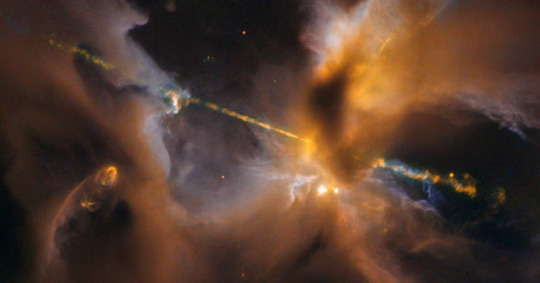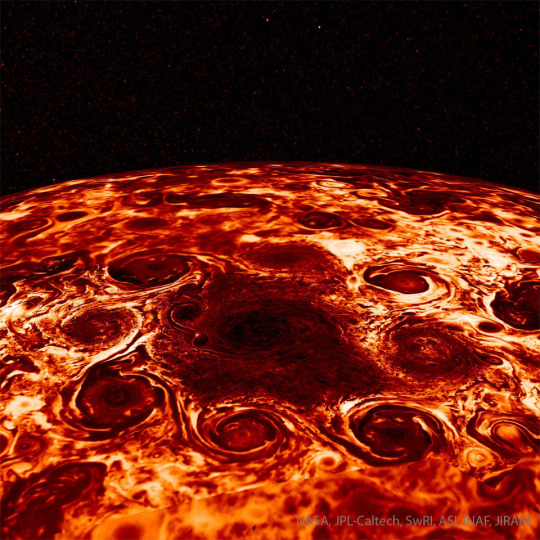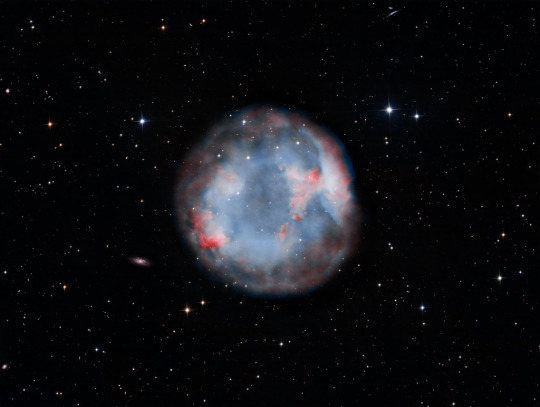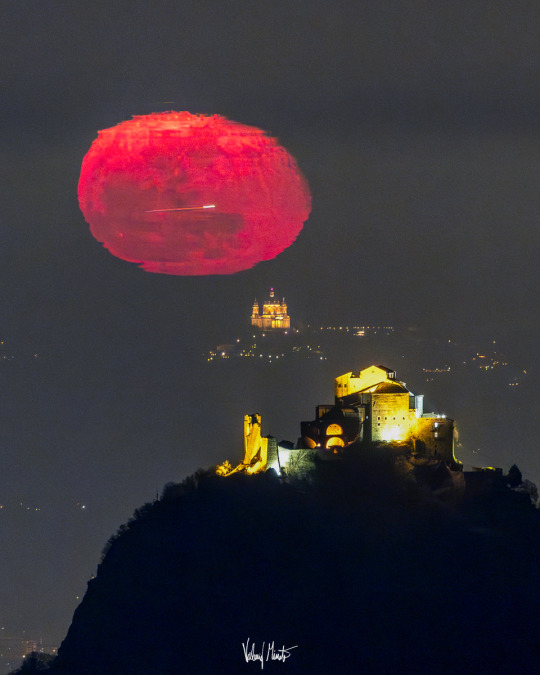Don't wanna be here? Send us removal request.
Text
Goodbye and Farewell

I started blogging here in 2018, it's been 7 years and for that, every single day I have posted here, it's been a whole load of fun sharing the beauty of our universe, but it's time for a little break and then I may move to Bluesky.
I want to thank you all for your regular visits, for your comments and most of all shared wonder.
I wish you all every good fortune and future prosperity, and most of all, more wonder and awe from up above.
62 notes
·
View notes
Text

M96 Through Patrick Moore's Eyes (according to Gemini)
Right, let's have a look at this celestial wonder, shall we? "Observe, if you will, the magnificent Messier 96. A veritable whirlpool of spiral arms, a cosmic Catherine wheel, swirling about its luminous core. A splendid, detailed portrait, indeed, of this island universe. Naturally, it's a spiral galaxy, and a grand one at that! Counting those fainter arms, stretching beyond the central brilliance, we find it spans a hundred thousand light-years, give or take. Quite comparable to our own Milky Way, wouldn't you say? Now, this M96, it resides some 38 million light-years distant, a dominant figure in the Leo I galaxy group. And, as you can see, the picture is positively teeming with background galaxies and smaller members of this Leo I cohort. But, the most intriguing, the most fascinating one, is that spiral galaxy, seen nearly edge-on, lurking behind an outer spiral arm, roughly at the one o'clock position. Its central bulge, so bright, yet dramatically bisected by those dark, obscuring dust clouds. A truly captivating sight! Now, it appears to be about one-fifth the size of M96. If, and this is a rather intriguing 'if', if it's comparable in actual size to M96, then, by Jove, it must be some five times further away! A truly staggering distance, wouldn't you agree? A testament to the sheer vastness of the cosmos! Marvellous!"
I do miss old Patrick, but the AI really went a little too much on the Anglicism's, I'm surprised it didn't include a Tallyho or spiffing what to add to the cheese.
19 notes
·
View notes
Text

Baby Stars Throw-up Too
We are all familiar with human babies occasionally throwing up what it has devoured, but baby stars can do this on a continuous basis.
MHO 2147, 10,000 light years from Earth is a baby star that is continually throwing material out into space, some 50 Trillian KM's worth of dust and gas outflows from it's polar regions, and is then lit up by the light and radiation coming from the baby star itself.
In some cases such baby stars can become herbig haro objects, it's the same process, but the outflow is confined to beam like outputs from those polar regions, similar to what you see with black holes.

While in both cases, the actual star is still hiding behind dust and gas, it will eventually run out of material to consume and become a stable main sequence star.
33 notes
·
View notes
Text

JWST Has Astronomers in a Spin, Just Like The Galaxies
Our star spins around the Milky Way in the same direction as almost all of the other stars and bodies of dust and gas, creating this beautiful spiral pattern.
But not all galaxies do so in the same direction, some from our perspective spin the other way. Before JWST, the expectation was, that a fairly even distributed universe should provide us with 50/50 examples of both, except, JWST seems to disagree.

Now, I'll hazard a guess that this odd statistical evidence didn't have you automatically jumping for "YES, we do all live inside a black hole!", but a team of scientists believe it could be evidence of exactly that, a theory known as Black Hole Cosmology, that suggests our entire universe exists within a black hole in another universe, and that all the black holes in ours, contain universes as well.
The theory postulates that there is no such thing as a singularity, but instead, when the gravity crushes those sub atomic particles towards infinity, the coupling between torsion, the twisting and turning of matter, and spin becomes very strong and prevents the matter from compressing indefinitely to a singularity.
The end result is, a bounce back, a period of expansion, not to dissimilar to the observable universe.

The reason they believe this is evidence, is because a universe created within a blackhole, could potentially favour the spin of that object in the other universe.
While it's impossible to really prove this, it's a fascinating idea, if not lacking some explanation to what happens when a black hole merges or devours a lot of mass and increases in size, certainly our universe doesn't suddenly double in size because another universe decided to join us, although I cannot prove it has never happened or won't happen in the future.
There is another more down to "Milky Way" explanation, we are sitting on a planet that is rotating itself around our own galaxy, and it could be that this messes up our view of the very distant universe, such that the opposite spin is more prevalent. I suspect this is more likely, and look out for the next paper out in the coming months, to show the spin is exactly this.
19 notes
·
View notes
Text

Webb Views NGC 2283
NGC 2283 isn't a galaxy you'll probably know much about, it's not had the focus some of the other galaxies close to us have, until now.

The best Hubble gave us was the above, not one of it's best, but a beautiful spiral with a blue ting along it's arms showing star formation.
JWST opens this up to see some huge star forming regions through the arms, and dark bubble features through out, likely the areas of supernova's carving out areas as it's bow shockwave expands outwards, pushing the dust and gas out.

The galaxy has a nearby partner galaxy IC 2171, both are located not far from the brightest star in the sky, Sirius.
34 notes
·
View notes
Text

Giant Pizza Found in Space
OK, it's not a pizza, it's a little bit larger, it's the northern pole of the largest gas giant planet in our solar system, the planet Jupiter.
The image is a false image showing the thermal profile, and showing up some absolutely mega storms orbiting around the pole.


65 notes
·
View notes
Text

Web Hunts for the Lower Mass Limit of Brown Dwarfs
What's the lowest mass a brown dwarf could be ? Not an easy question to answer when so few are known, but JWST has been able to peer through the dust and gas of star forming regions, and pick out brown dwarfs as they are made.

Peering into the Flame Nebula, NGC 2024 it has been able to catalogue a significant number, and as the mass reduces, so does the quantity of finds, down to in or around 2-3 Jupiter masses.
The assumption is, this is the limit of size for such failed stars.
61 notes
·
View notes
Text

NGC 4900
This recent image comes from Hubble, who is still out there taking images decades after it first graced our orbit.
The idea behind this image was to compare it to one taken back in the 1990s, to look for stars that we know have since gone supernova, and see if we can still see the aftermath, the mass of the stellar remnant among other things of interest.

The bright star in the image is one of our own, in the Milky Way galaxy and just happens to be in front, but looking closely at the galaxy, you can see a large amount of star formation, and hence the large amount of supernovae being searched for.
66 notes
·
View notes
Text

Webb Peers into Lynds 483
It's a beautiful sight, and in some ways reminiscent of the display of when a sun sized star dies, especially when it has a partner, creating these hourglass/butterfly like displays, but this is no dying star, quite the opposite, it's one yet to finish.
Webb captures the material outflows from the poles of the stars (the butterfly wings) and a strange dark shadow that follows the equatorial regions.

This is the dust and gas and shadow of the forming accretion disk around the planet, blocking the stars at the centre from even JWST.
Eventually the dust and gas will reach an equilibrium with gravity, and the stars will lose their wings, and gain planets, creating a system similar to Alpha Centauri with 2 main sequence yellow G type stars.

Backing out a little, you can see how the dust and gas is blocking the view of the stars as you approach the object at the centre, giving a better view of how accretion disks form and eventually settle to create the planets.
39 notes
·
View notes
Text

NGC 206 - The Andromeda Star Cloud
Andromeda galaxy isn't just the closest full scale galaxy to us (not counting the dwarf galaxies) but it has some incredibly interesting features.
One such feature is NGC 206, an huge area of the galaxy with dense blue star formation.
In our own Milky Way, most areas with large amounts of blue stars are contained within the pink glowing areas we know as nebula, which create the open clusters of blue stars.
But here a huge bank of dust and gas, and within and behind it, a cloud of stars similar to the smaller more yellow ones we'd see in our own galaxy or in spiral galaxy core's (the longer living stars that can make it there before going supernova).

Here you can see it with more context to the entire galaxy, and being blue, means most of these stars will only be 10-100 million years old, meaning this whole region must have been going through huge star birth in the not so distant past, as some parts still are and can be seen as the red areas in the upper image, in and around the dust cloud.
49 notes
·
View notes
Text

Planetary Nebula Abell 7
This planetary nebula, this transient spectacle, represents a fleeting, yet profound, chapter in the life of a star. It is a glimpse into our own future, a preview of the fate that awaits our Sun, some five billion years hence. The central star of Abell 7, a once luminous sun-like orb, now fades into a white dwarf, a stellar ember cooling across the eons. It has shed its outer layers, a cosmic shedding of skin, leaving behind this luminous shroud, this testament to its passing.
We estimate Abell 7 to be a mere 20,000 years old, a cosmic blink of an eye compared to the ten billion years of its central star's existence. Ten billion years, a span of time that dwarfs the entirety of human civilization. Within this vastness, within this cosmic drama, we find echoes of our own origins, and a glimpse of our ultimate destiny. We are star stuff, contemplating the very processes that gave rise to us, and to the cosmos itself. The cosmos is within us. We are made of star-stuff. We are a way for the universe to know itself.
Text reworded from APOD by Gemini AI in the style of Carl Sagan, some of you may have guessed already.

36 notes
·
View notes
Text

She Asked for a Diamond Ring
But being an astronomy geek, I gave her something so much more precious, the galaxy M94. I have her 40 billion stars, with a shockwave ring of diamonds made of B and O type stars, set in clusters with a ruby glow only hydrogen can do when bombarded by UV light from these diamonds.
And the whole thing has been 13 billion years in the making, a special kind of precious, but the ring was thought to be created much sooner, just a few million years ago (from our perspective), and likely from a shockwave emanating from the supermassive black hole. The only problem is, it's 16 million light years away, but maybe that means, we'll travel together forever to reach it.
45 notes
·
View notes
Text

The Baby Eagle Nebula
Also known as LBN 777 Lynds' Bright Nebula catalogue, the opposite to LDN Lynds' Dark Nebula catalogue, is an area of dust and gas reflecting the light of nearby stars.

Part of a much larger Taurus Molecular Cloud, a nearby star forming cloud of dust and gas, thought to be a few million years old.
32 notes
·
View notes
Text

JWST's View of the Galactic Core
The James Webb Telescope's NIRCam captured a stunning image of the Milky Way's center, revealing 500,000 stars and previously unseen features within a 50 light-year wide region. This detailed view shows ionized hydrogen surrounding dark clouds, forming stars, and other complex structures, prompting extensive study of the unprecedented data
32 notes
·
View notes
Text

Distorted Red Moon
Yep, it's a real picture, taken by Valerio Minato (https://www.instagram.com/valeriominato/)
The moon is visibly distorted, due to the turbulence of the Earth's atmosphere. When any object rises into the sky (or sets), the amount of atmosphere that light needs to travel through is significantly longer, and therefore more lensed (hence the size of the moon) and distorted. The colour red is a result of the absorption of the blue, leaving a more red coloured light when it arrives to you at the ground.
And finally, the aircraft, that just happened to be passing between the observer and the moon.,
32 notes
·
View notes
Text

Guess the Constellation ?
It may look a little similar to a rather famous constellation in the northern sky, but then, the pan is looking more like a jug, and somebody broke the handle!
It is in fact, Ursa Major, but not as you see it today, but as it will be in 100,000 years from now.

Go back 50,000 years ago, and you'll spot the same two stars Alkaid and Dubhe are now in very different locations again, more like a hammer than a big dipper.
Our human lives are too short to really spot the movement of most of the stars, what is known as stellar drift, as the stars move around the galaxy, they follow their own path and that means sometimes we are close by and over time we move away, and new stars join us on our orbit around the centre of the galaxy.

If we look at the distances of these stars, an interesting pattern emerges, apart from Alkaid and Dubhe, all the other stars are moving in the same direction and are almost the same distance from us.
The reason for this is, they were all likely born in the same nebula, and have been moving together. It's not just these stars either, there's a fair number that seem to follow almost identical distance and direction and speed, this is known as the Ursa Major moving cluster.
The two stars that appeared to have moved the most, belong to a different grouping and are moving in a different way from our perspective and will eventually destroy this beautiful asterism in our sky.
But fear not, our brains are hard wired to see shapes where they are not, and no doubt new asterisms will form and entertain future generations.

29 notes
·
View notes
Text

The Rho Ophiuchi Cloud Complex
Just 390 light years from Earth in the constellation of Ophiuchus is a small star forming region, which when JWST took a look a year into its service, showed it to be a dynamic area of star formation, with sun like stars being born.
The area is part of a much larger area of dust and gas near the bright star Antares, that sits behind it by another 100+ light years.

and a great area of the sky to turn binoculars or small telescopes towards, to see the globular cluster M4 some 5,000 light years behind, but one of the brightest and closest globular clusters to our planet.
51 notes
·
View notes